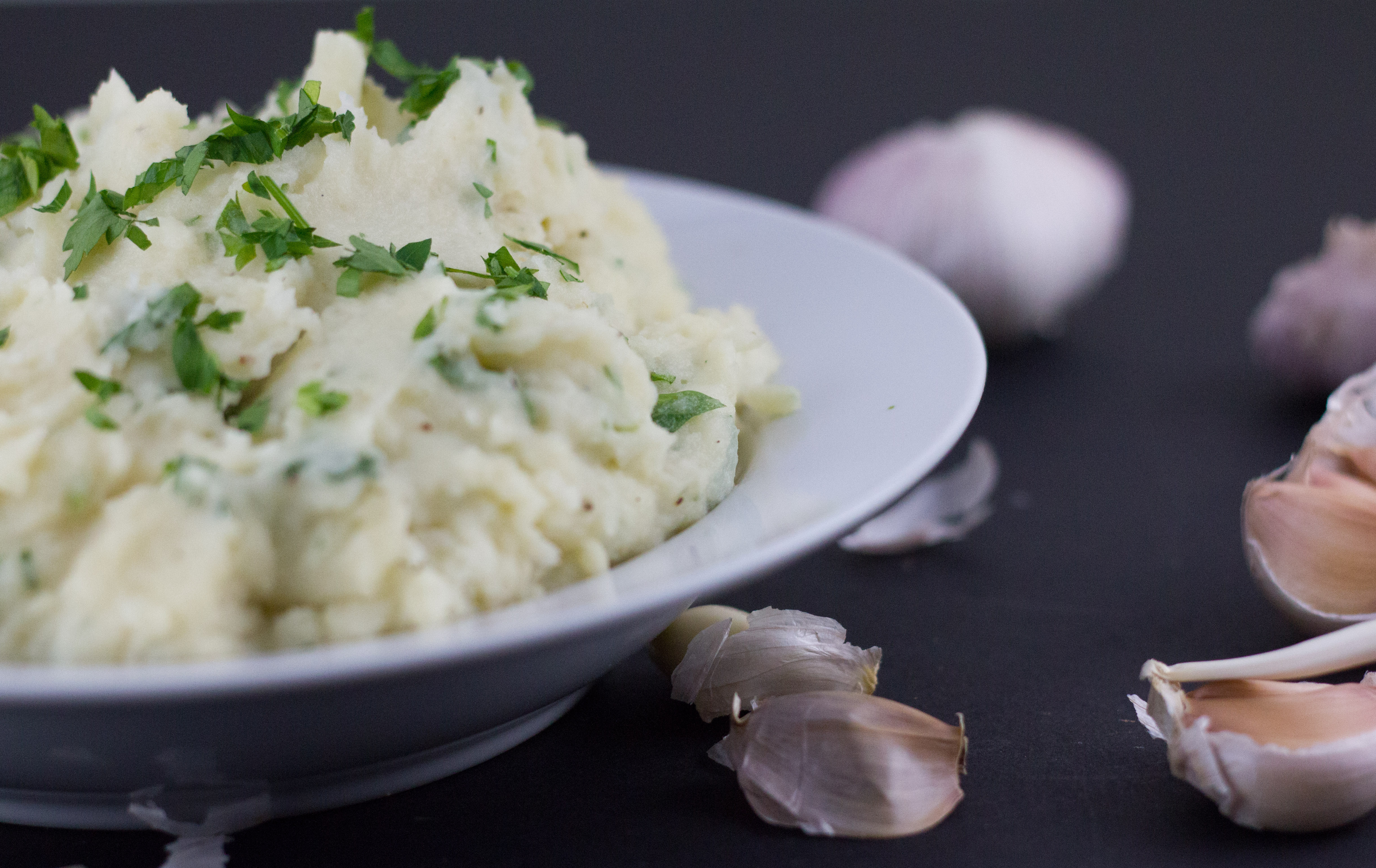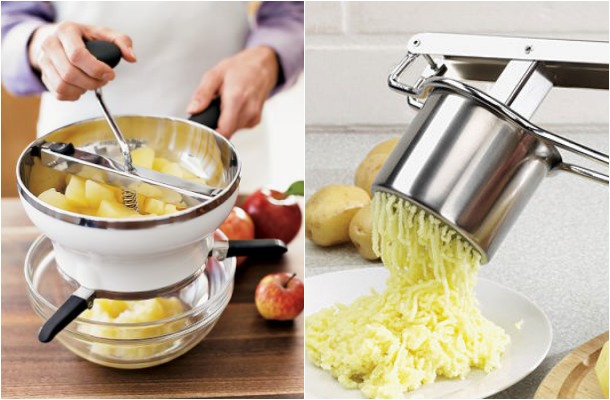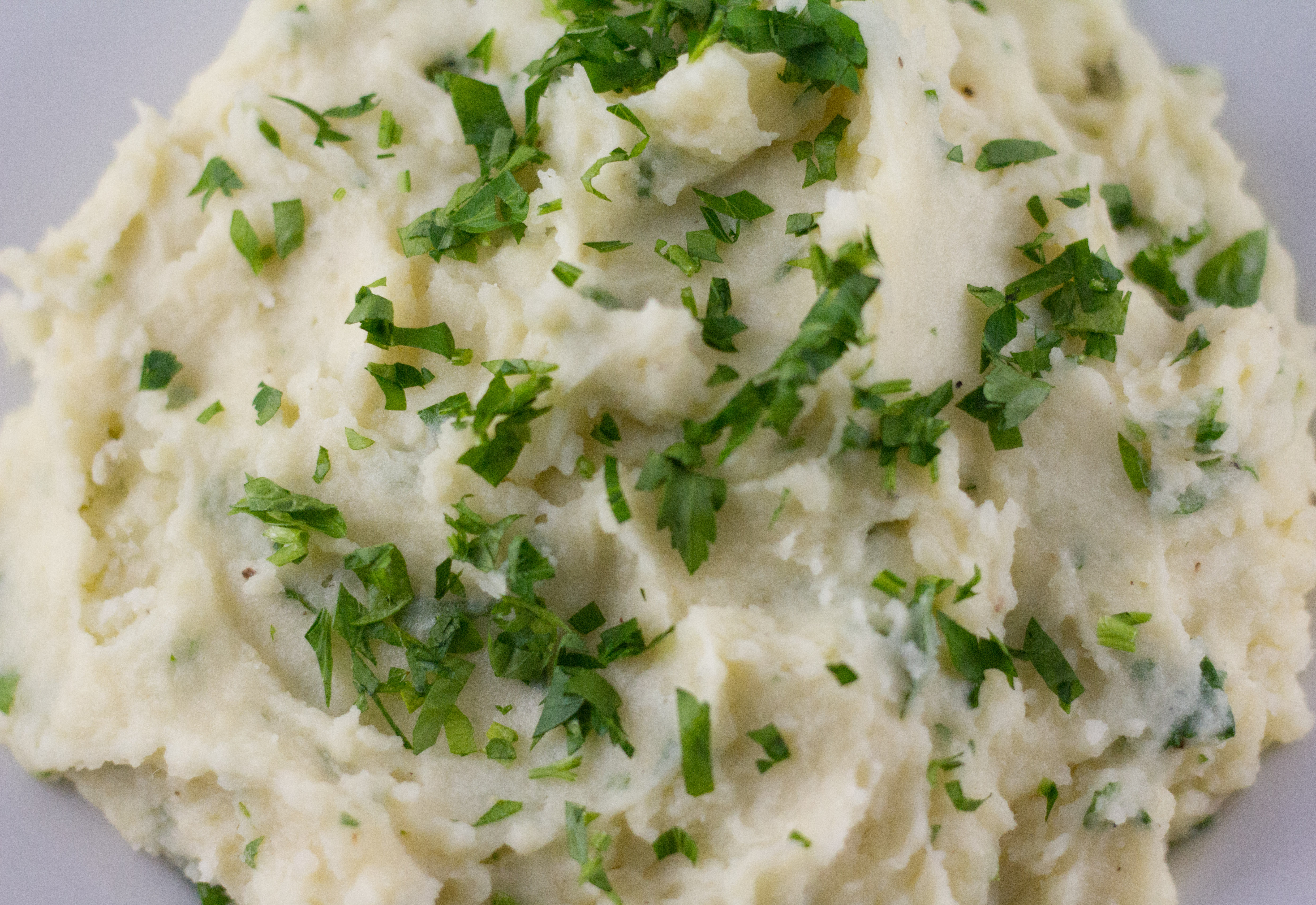
A couple weeks ago, I discovered this Julia Child recipe for garlic mashed potatoes. It uses no less than 30 cloves of garlic, and since I grew up around garlic (my family used to own a kimchi company), this immediately drew me in.
In her recipe, garlic is blanched, peeled and cooked in butter until soft. With the help of some flour, milk and a blender, this becomes a rich, garlic-flavored bechamel which gets stirred into the mashed potatoes.
The only thing is, starch is what accounts for that glue-y texture of mashed-potatoes-gone-wrong. (The starch granules absorb water while cooking, then when they're broken up during mashing, release sticky starch molecules. You can read more about it here.) So wouldn't the addition of more starch, in the form of flour, only aggravate that?

The answer is yes. Even after my precautions--drying out the drained, cooked potatoes in a warm pot, and using a ricer to process them more quickly than a masher would--the potatoes stiffened before the bechamel had a chance to fully mix in. The result was edible, but far from successful.
I admired Child's prodigious use of garlic, though, so keeping this mind, I turned to J. Kenji Lopez-Alt and Daniel Gritzer of Serious Eats for help.
There are basically 4 things you can do to steer clear of sticky mashed potatoes:
- Remove as much starch as possible.
Less starch = fewer "balloons" that will absorb water, break and release sticky starch molecules into the potatoes. To do this, Kenji cuts peeled potatoes into relatively small pieces, revealing more surface area, then gives them a good rinse before and after cooking. - Remove as much moisture as possible.
After the cooked potatoes are rinsed in hot water, they'll of course be wet. More water means more moisture to be absorbed by starch granules, which will, you guessed it, break and release sticky starch molecules. Gritzer quickly dries the potatoes out in a hot oven to after rinsing. - Disturb the potatoes as little as possible.
The trick here is to process and season the potatoes efficiently without breaking up too many starch granules. There are two tools that work best for truly fluffy mashed potatoes, and a potato masher isn't one of them. You'll want to use a food mill or a potato ricer (I found mine for $15 at a restaurant supply store), which quickly turn potatoes into fluffy, lump-less strings without overworking them like a hand masher can. If you have the storage space, a food mill is a much more versatile tool (you can make applesauce, tomato sauce and seedless jam with it, too). - Butter first, then cream.
Adding liquid directly to the potatoes in the form of hot milk or cream can undo all that extra work you just did. Coating the potatoes with butter first helps the starch granules absorb less moisture once the liquid is added.

OXO food mill, popsugar.com; potato ricer, Express
A couple other general tips whenever working with potatoes:
- Drain the potatoes as soon as a fork, paring knife or cake tester can go in and out without resistance. You don't want the potatoes to sit in the hot water any longer than they have to, for reasons previously discussed.
- Salt, salt, salt. Be generous - taste as you go, but know that it's pretty difficult to overseason potatoes.

I know it sounds a little complicated (all this for mashed potatoes?), but the extra steps are worth it, and not too much more time consuming. If made with caution, you could even make these a day ahead, refrigerate it in a baking dish covered with foil and reheat it in the oven--they'll still be fluffy. Win win for everyone.
Click here for more OOT Thanksgiving recipes!
Fluffy Garlic Mashed Potatoes
Recipe courtesy of Out of Thyme (adapted from Serious Eats and Julia Child)
Yield: 6 servings | Prep Time: 15 minutes | Total Time: 1 hour
30 cloves garlic, separated and unpeeled
8 tablespoons (1 stick) unsalted butter
1 1/4 cups half and half
Kosher salt and freshly cracked black pepper
2 1/2 pounds (about 4 large) Russet or Idaho potatoes, peeled, diced into 1- to 2-inch pieces and covered in cold water
1/4 cup chopped fresh parsley (Julia Child uses parsley, which I had on hand, but chives are always good, too)
Special equipment: a food mill or potato ricer
Bring water up to a boil in a medium saucepan. Carefully put the garlic in the water and blanch for 2 minutes, then remove the garlic to a bowl. Squeeze the garlic cloves out of their skins.
Add 2 tablespoons of the butter to a small saucepan over medium heat, add the peeled garlic and cook until tender, about 10 minutes. Add the half and half and bring to a simmer. Transfer everything to a blender (or use an immersion blender), blend until smooth, season with salt and pepper and reserve in the saucepan until ready to use.
Rinse the diced potatoes under cold water, changing the water out 2 to 3 times, until the water runs clear.
Preheat the oven to 350 degrees F and bring 4 quarts of water to a boil in a stockpot or large saucepan. Add the potatoes and cook until tender (a fork, paring knife or cake tester should go in and out without resistance), about 15 minutes.
Bring the half and half mixture back to a simmer. Drain the cooked potatoes into a colander and rinse under hot water for 30 seconds to remove any excess starch. Spread the potatoes onto a large baking sheet and dry them out in the oven for about 6 minutes. Pass the potatoes and the remaining 6 tablespoons of butter through a food mill or potato ricer over a large bowl. Stir to incorporate the butter, add another healthy pinch of salt and gently stir in the half and half mixture and most of the parsley. Adjust seasoning and top with the remaining parsley.







No comments:
Post a Comment